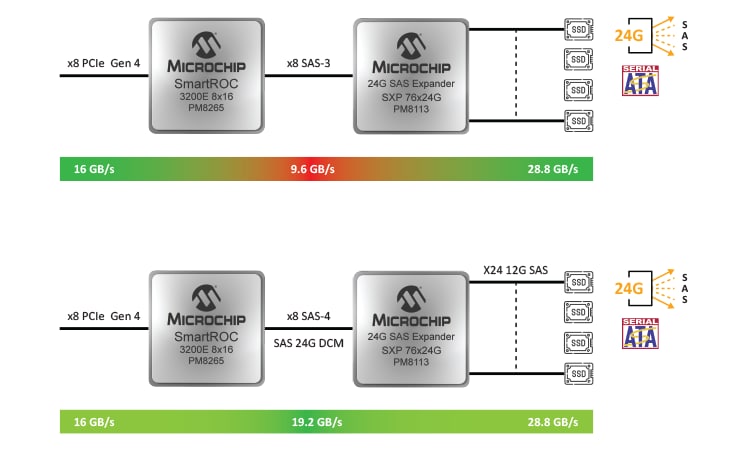Dynamic Channel Multiplexing (DCM)
DCM drives SAS link utilization to near 100% on 24G SAS initiator-expander and 24G SAS expander-expander links regardless of block sizes or mix of drive rates and media types.

Microchip’s Dynamic Channel Multiplexing (DCM) link aggregation technology enables cloud, datacenter, server, and storage solutions to take full advantage of 24G SAS data rates while utilizing unmodified and existing 6G and 12G media endpoints and infrastructure. DCM delivers improved SAS link efficiency while eliminating some of the unfairness and drive starvation issues found in traditional SAS/SATA buffering. All Microchip’s 24G SAS capable products support DCM. DCM drives SAS link utilization to near 100% on 24G SAS initiator-expander and 24G SAS expander-expander links regardless of block sizes or mix of drive rates and media types. DCM therefore reduces component and cabling costs, extends the useful lifetime of existing 6G SAS/SATA and 12G SAS based infrastructure and lowers on-going support costs.
The need for technologies like DCM technology and SAS/SATA buffering arises due to the connection-oriented nature of the SAS protocol when higher rate connections are used to serve lower rate media targets. During a SAS connection, an open connection established between an initiator and a target owns the resulting initiator PHY, the physical pathway through SAS expanders, and the target PHY for the duration of the SAS connection. This connection blocks other traffic while the connection is open. When servicing lower rate media, DCM and SAS/SATA buffering provide different solutions for efficiently utilizing the higher rate connection.
DCM breaks the single data channel one-to-one exclusive relationship established between an initiator and target by enabling multiple logical data channels between the initiator PHY and multiple targets. This is accomplished by modifying the SPL packet encoding to add a logical channel marker to each SPL packet to support four logical connections. Every DCM packet is tagged with a channel marker. Each successive SPL packet can be allocated to any of these four logical channels and the mixture of traffic carried by each logical channel on the physical PHY can vary over time. This dramatically increases overall system bandwidth and reduces latency by enabling cut through routing through expanders. DCM is fully interoperable with existing SAS/SATA infrastructure, and is 100% Physical Layer compatible with standard SAS-4. DCM capable devices automatically detect and transition into DCM operating mode during SAS speed negotiation. On the other hand, SAS/SATA buffering requires the expander to manage additional SAS protocol commands to aggregate lower rate 6G or 12G traffic in the expander and then burst that traffic at the higher 24G rates with the initiator – lowering overall bandwidth and increasing both complexity and latency compared to DCM.
See how DCM works.
Microchip has partnered with Teledyne LeCroy to enable DCM SAS trace analysis and jamming support in the SAS Sierra T244 and SAS Sierra M244 products
In summary, the benefits of designs using DCM:
• Increased system performance by increasing SAS utilization to near 100%
• Providing a performance boost to existing 12G and 6G based storage infrastructure
• Full-duplex on all Controller-Expander links (CONFRIM)
• Reduced latency compared to SAS/SATA buffering
• Eliminating unfairness/bandwidth starvation effects of SAS/SATA buffering
• Reduced cabling and component costs -> few PHYs/cables
DCM is fully supported in all of Microchip 24G SAS capable products. These storage products include Microchip's fourth generation Serial Attached SCSI (SAS) expander (SXP 24G) and fifth generation storage
SmartROC 3200/SmartIOC 2200 families of devices.